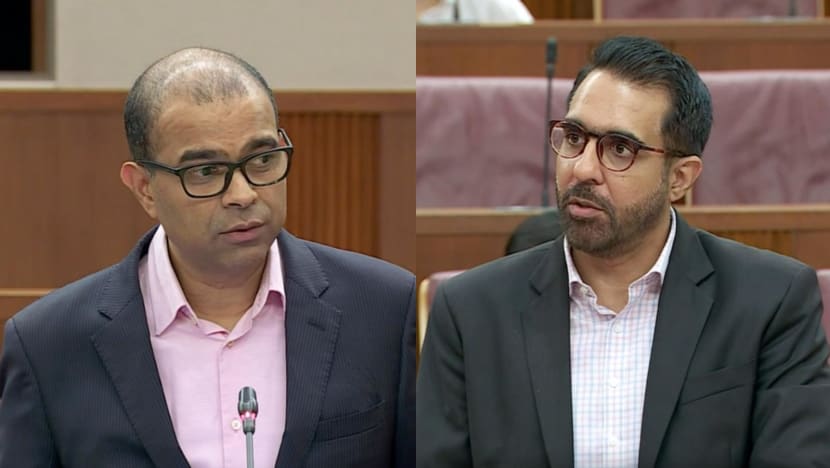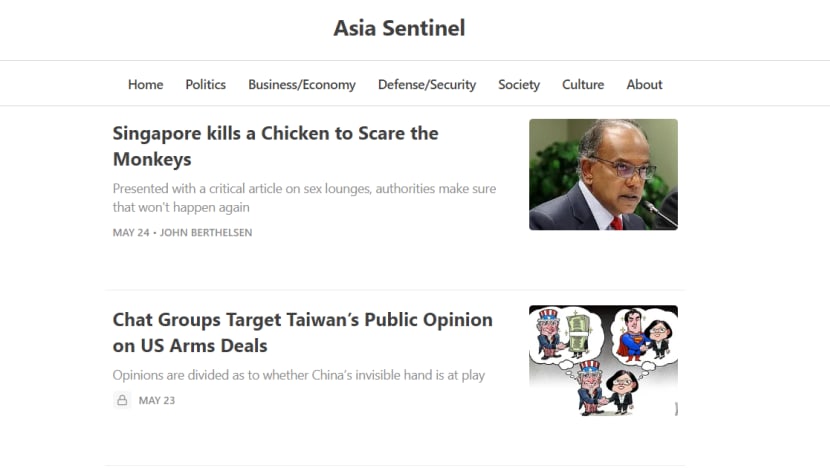Asia Sentinel had to carry POFMA notice on main page to reach as many readers as possible: Janil Puthucheary
Leader of the Opposition Pritam Singh questioned why Asia Sentinel needed to carry a correction notice not only on the page hosting the article, but also on its main page.

Senior Minister of State for Communications and Information Janil Puthucheary (left) and Leader of the Opposition Pritam Singh in parliament on Aug 3, 2023.
SINGAPORE: Online publication Asia Sentinel was required to carry a government-issued correction notice on both its main page and the offending article in order to reach as many readers of the original article as possible, said Senior Minister of State for Communications and Information Janil Puthucheary on Thursday (Aug 3).
The government also takes into account the design of the website and article in question, given the “significant amount of leeway and freedom” in how online sites are designed and published, he told parliament.
Dr Puthucheary was responding to a parliamentary question filed by Leader of the Opposition Pritam Singh on a correction direction issued to Asia Sentinel under the Protection from Online Falsehoods and Manipulation Act (POFMA) about two months ago.
The California-registered publication was required to carry a correction notice alongside its May 24 article, titled Singapore kills a Chicken to Scare the Monkeys, as well as at the top of the main page of its website.
On Jun 2, internet access service providers in Singapore were ordered to block Asia Sentinel after it did not fully comply with the correction direction.
It did not carry a correction notice at the top of its main page. The notice on its article was also placed below an editor's note which stated the online publication was "reserving the right to answer their (the Singapore government's) demand at a future time" and that "we stand by our story".
Mr Singh asked why the government needed Asia Sentinel to include a correction direction not only on the page hosting the article, but also on its main page.
Dr Puthucheary noted that a correction direction will specify the form and manner in which correction notices are to be published.
“The intent is to try to have the correction notice reach at least as large a readership as the original falsehood, so often, this may be difficult to achieve,” he said.
Dr Puthucheary added that in this case, Minister for Home Affairs K Shanmugam specified that Asia Sentinel publishes a correction notice at the top of the page that hosted the article containing the false statements of fact, and at the top of the main page of its website.
“The inclusion of the POFMA correction notice on more than one location on Asia Sentinel’s website is to try and achieve the objective that I stated above,” Dr Puthucheary said.
“The Act also allows other orders to be made to get the correction notice brought to the attention of the readers who may have read the original falsehoods.”

QUESTION OF OVERREACH
Mr Singh asked how the government decides that a correction notice should also be included on a website’s main page.
He said: “Can there not be a question of overreach when you expect the correction direction to be on the main webpage as well?
“Because having it on the article itself would be sufficient because then, the reader would know that this particular article is the one that has been flagged out – not every article on the Asia Sentinel website.”
In response, Dr Puthucheary said: “I think you would characterise this as overreach only if you felt that the inclusion of the correction notice ... was itself not necessary or was itself false, or that it was inappropriate to have this viewed by as many people as possible.”
He added that he was sure Mr Singh, who was part of the Select Committee that produced a White Paper that led to POFMA, would agree that “a lie travels faster than the truth”.
Dr Puthucheary further noted that people do not often return to an article after reading it, so the government needs to ensure that as many of these readers will know the original falsehood has been corrected.
“So, we need a variety of tools. And depending on how the site is laid out, depending on how the publisher manages its material, propagates its material – there needs to be some assessment of that done to make sure then that the correction is visible,” he added.
However, even by requiring websites to publish a correction notice on its main page, it is unlikely that all readers of the original falsehood will realise there is such a notice, Dr Puthucheary noted.
Mr Singh reiterated that he was asking about what the threshold was, and whether the government was changing its approach on POFMA correction directions to a stricter one.
He also asked for confirmation if a more heightened approach was taken for Asia Sentinel because it ignored other correction directions in the past.
Dr Puthucheary replied that correction notices “add further information and transparency for people to make up their own mind about the facts at hand”.
He also gave an analogy of a print publication publishing a falsehood, noting that Mr Singh would not be satisfied if a magazine or newspaper only published a correction notice next to its original article.
“Nobody’s going to read the newspaper again from three or four days ago,” Dr Puthucheary added.
“And he would require a notice carried in the same publication in a prominent place that people could read, and especially to do so in a way that as many of the readers of the original false statement were then better informed.”
Mr Singh said no one expects a print publication to publish an apology on its front page.
“So that's the nub of the issue here,” he added. “I can accept, actually, an argument which goes along the line of egregious conduct, repeated egregious conduct ... I think that's fair.”
Dr Puthucheary responded that the requirement of publishing a correction notice on a website’s main page “should not be predicated on a certain number of strikes, as it is not a fixed threshold”.
“It needs to take into account – for example – the design of the website, the way in which links are made to other feeds because otherwise the process can be gamed,” he added.
“There is a significant amount of leeway and freedom in how online sites are designed and published. So we take into account the design of the website, the feed, the way in which user behaviour is guided by that, but also the kind of content and the kind of notice that is required.”
As for Mr Singh's query on how many correction directions have been issued to online sites requiring them to publish correction notices on both their main page and the article, Dr Puthucheary said he would get back separately to Mr Singh with the information.


















